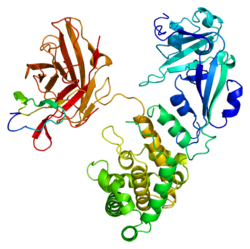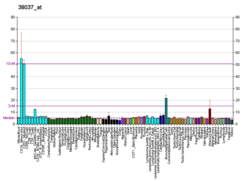Heparin-binding EGF-like growth factor
Heparin-binding EGF-like growth factor (HB-EGF) is a member of the EGF family of proteins that in humans is encoded by the HBEGF gene.
HB-EGF-like growth factor is synthesized as a membrane-anchored mitogenic and chemotactic glycoprotein. An epidermal growth factor produced by monocytes and macrophages, due to an affinity for heparin is termed HB-EGF. It has been shown to play a role in wound healing, cardiac hypertrophy, and heart development and function. First identified in the conditioned media of human macrophage-like cells, HB-EGF is an 87-amino acid glycoprotein that displays highly regulated gene expression. Ectodomain shedding results in the soluble mature form of HB-EGF, which influences the mitogenicity and chemotactic factors for smooth muscle cells and fibroblasts. The transmembrane form of HB-EGF is the unique receptor for diphtheria toxin and functions in juxtacrine signaling in cells. Both forms of HB-EGF participate in normal physiological processes and in pathological processes including tumor progression and metastasis, organ hyperplasia, and atherosclerotic disease. HB-EGF can bind two locations on cell surfaces: heparan sulfate proteoglycans and EGF-receptor effecting cell to cell interactions.
...
Wikipedia



